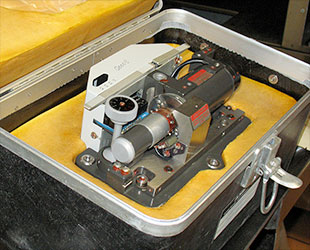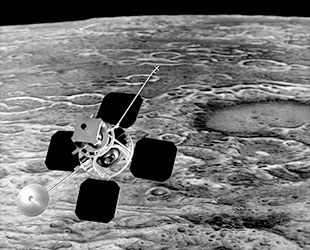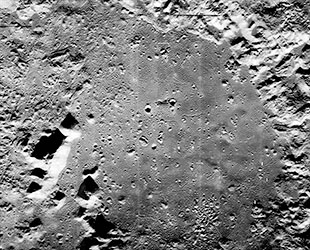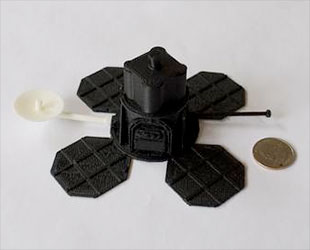March 18, 2013 — A five-year effort to recover nearly 50-year-old images of the moon is seeking public support to keep the project going.
The Lunar Orbiter Image Recovery Project (LOIRP) has since 2008 been reprocessing the data received from five unmanned spacecraft that were launched by NASA in the 1960s. The Lunar Orbiters, tasked with imaging potential landing sites for the Apollo manned missions that were set to follow, made their own history by taking the first photos from lunar orbit.
Started with funding from volunteers and initially supported financially by NASA, the LOIRP team of retired engineers and scientists, together with students, have recovered and enhanced 600 out of the more than 1,400 images taken by the Lunar Orbiters in 1966 and 1967.
The project was made possible by pairing the program's tape drives, found inside a farmer's barn, and analog data tapes with modern laptops and spare parts purchased off eBay. Run on a shoestring budget, the project is housed in an abandoned McDonald's located near NASA's Ames Research Center in northern California.

Tape drive head from the Lunar Orbiter Image Recovery Project's AMPEX FR-900 2-inch analog tape drive. (LOIRP) |
Their NASA funding exhausted, the LOIRP team has now turned to online crowd-funding for the backing needed to finish processing the remaining 850 images of the moon. At the time this article was published, nearly $40,000 had been raised toward the team's goal of $75,000 through the RocketHub website.
The funds raised so far have allowed for the refurbishment of two of LOIRP's five tape drive heads. The team is also looking to pay the engineering team that maintains the 50 year old tape drives.
Two days remain for the public to contribute. In return, the LOIRP team is offering a number of Lunar Orbiter-related collectibles, ranging from a 3D-printed model of the moon probe to vintage prints and microfilm copies of the original Lunar Orbiter imagery.
Peering into the moon's past
The five Lunar Orbiter missions predated even the earliest attempts at digital photography by nearly a decade and so to transmit their images back to Earth, each spacecraft carried the equipment to develop and then scan the film it captured. The resulting transmissions, once on the ground were then printed in long strips and manually reassembled to form complete images.

Artist's rendition of a Lunar Orbiter circling the moon. (NASA) |
The images were low resolution — they were essentially copies of copies — but they were good enough to identify potential landing sites for Apollo missions to the moon.
Fortunately, the foresight existed to also record the data transmissions onto analog tapes.
By rescanning those tapes, which if it was not for LOIRP were at risk of being erased — the team has been able to do more than reproduce the same low resolution images seen 47 years ago, but enhance the resolution to reveal new details. The result is more than just producing striking photos — although the project has done that too, including the iconic "Earth rise" image and the so-called "picture of the century," an oblique view inside the crater Copernicus — but developing new data for scientific study.

Mosaic of the moon's Copernicus crater floor as imaged by Lunar Orbiter V and recently released by LOIRP. (LOIRP/NASA) |
By comparing the newly-recovered Lunar Orbiter images to the photographs taken more recently by NASA's Lunar Reconnaissance Orbiter launched in 2009, changes on the moon's surface can be identified. Students working with the LOIRP team have already looked for the signs of lunar quakes, meteor impacts, and volcanism.
All the LOIRP recovered images are being provided to the National Space Science Data Center, where they will be archived for the science community, and shared online for the public to see. The team is providing the full-resolution images at no cost, in part because the data was originally obtained with tax dollars and because they want to make the photos available to as many people as possible.
History for enabling history
The Lunar Orbiter Image Recovery Project's crowdfunding campaign accepts donations of any amount, but the team has offered up some perks for those backing the effort at different levels of support.
For a $50 donation, funders will receive a microfilm copy of a Lunar Orbiter image that was produced by NASA's Langley Research Center after the missions had come to their end. For $250 (and more), supporters can receive a vintage glossy print of a Lunar Orbiter image.

A 3D-printed model of Lunar Orbiter is offered for $225 and $400 donations to the Lunar Orbiter Recovery Project. (LOIRP) |
At the $225 and $400 levels, backers will receive a 3D-printed scale model of the Lunar Orbiter spacecraft. At the higher donation level, a lunar surface base is also included to display the miniature orbiter as if it was peering down at the moon's Copernicus crater.
For those donating $500 to $1,000, the team has original 1960s Lunar Orbiter images, ranging in size from strips to large panoramas. And for supporters donating $5,000 and more, a "mystery prize" awaits, which the team describes as a "very unique part of Lunar Orbiter history."
The RocketHub campaign is scheduled to end Wednesday (March 20) at 11 p.m. EDT (0300 GMT March 21).
For more details, see the LOIRP MoonViews.com website or to donate, the RocketHub campaign.
